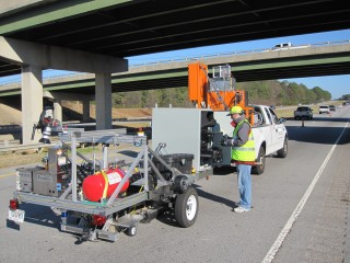By Kalwinder KaurJun 20 2012
A team from the Georgia Tech Research Institute (GTRI) has developed a new prototype system for the automatic detection of cracks on roads and pavements and sealing the same. The research is being funded by the Georgia Department of Transportation.
 Researchers at the Georgia Tech Research Institute developed the prototype automated pavement crack detection and sealing system shown here. An automated crack sealing system would increase the level of safety for the workers involved, require fewer personnel and increase the amount of roadway covered per day
Researchers at the Georgia Tech Research Institute developed the prototype automated pavement crack detection and sealing system shown here. An automated crack sealing system would increase the level of safety for the workers involved, require fewer personnel and increase the amount of roadway covered per day
The detection of cracks on time and sealing them ensures the safety and integrity of the road. However manual detection of these cracks can result in grave danger for the workers since they have to work under heavy traffic. To resolve this issue, the research team has developed a new prototype system which has the capability to detect cracks which were smaller than one-eighth inch wide and can seal the cracks from vehicles moving at a speed of three miles per hour.
For experimental purposes, the system was mounted on a trailer. The system consists of a stereo camera, LEDs in two colours and an arrangement to ensure the continuous supply of sealants to a longitudinal traverse sealant distribution system. When the trailer moved on the road, the LEDs illuminated the road in both parallel and perpendicular directions and the stereo camera takes pictures of the road. These pictures are simultaneously analysed through the use of filtering algorithms. The computer onboard the system generates a crack map indicating the location and shape of the crack if there is any. When a crack was found, the master controller provided instructions to the sealant applicator on when to fire. However before this system can become commercial several issues need to be addressed such as the quality of the algorithm used and a 3-D laser scanning system needs to be implemented to ensure a full scale system.
Disclaimer: The views expressed here are those of the author expressed in their private capacity and do not necessarily represent the views of AZoM.com Limited T/A AZoNetwork the owner and operator of this website. This disclaimer forms part of the Terms and conditions of use of this website.